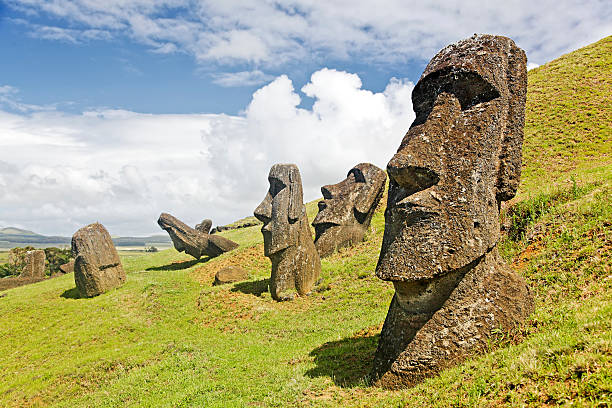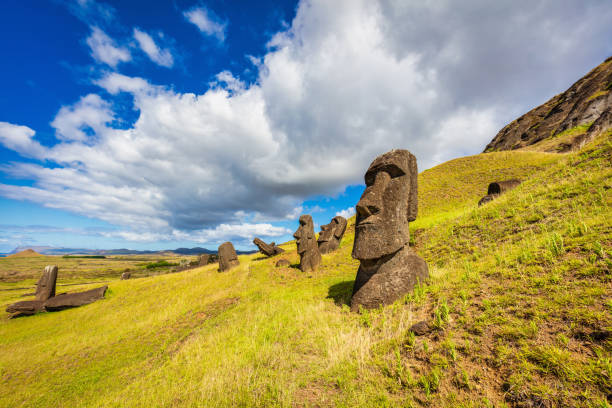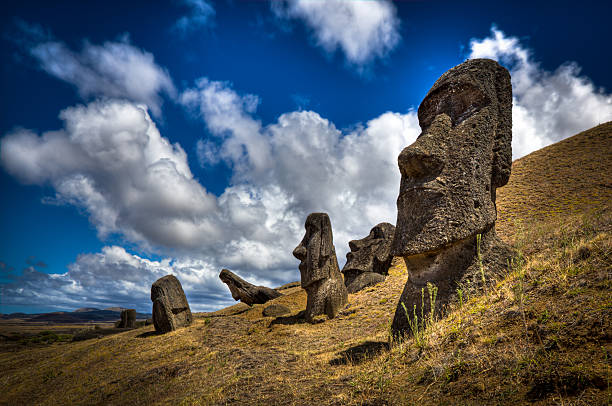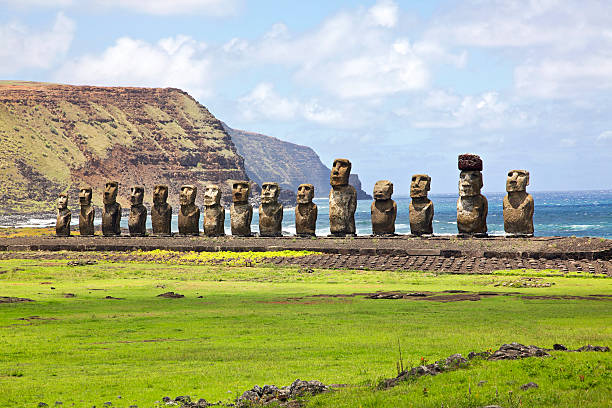Rapa Nui National Park: Guardians of the Moai and Polynesian Heritage
Introduction to the World's Most Isolated Cultural Treasure
Rapa Nui National Park, encompassing nearly half of Easter Island's total area (approximately 7,150.88 hectares or 43.5% of the island), stands as one of the most remarkable cultural landscapes on Earth . Located in the southeastern Pacific Ocean, this Chilean territory forms the easternmost point of the Polynesian Triangle, lying 3,700 kilometers (2,300 miles) west of continental Chile and about 2,200 kilometers (1,400 miles) east of Pitcairn Island, its nearest inhabited neighbor. The park's global significance stems from its collection of 887 monumental stone statues called moai, created by the Rapa Nui people between approximately 1250 and 1500 CE, which represent one of humanity's most extraordinary artistic and engineering achievements . These silent sentinels of volcanic stone, ranging from 2 to 20 meters (6 to 65 feet) in height and weighing up to 80 tons, dominate the island's grassy slopes and coastal platforms, telling a story of a sophisticated megalithic culture that developed in complete isolation from external influences .
The park's triangular shape stretches 23 kilometers (14 miles) in length and 11 kilometers (6.8 miles) in width, containing a dramatic landscape of extinct volcanic craters, freshwater lakes, rugged sea cliffs, and the iconic moai standing watch along the coastline . Elevations range from sea level to 300 meters (980 feet) at the summit of volcanic cones, creating a varied topography that the ancient Rapa Nui people navigated with remarkable skill to transport their massive stone creations . The island's climate is subtropical, with average temperatures varying from 19°C (66°F) in winter to 24°C (75°F) in summer, and annual rainfall averaging 1,250 millimeters (49 inches), mostly falling during the winter months. Southeast trade winds blow from October to April, shaping both the environment and the living conditions of the island's ancient and modern inhabitants.

UNESCO recognized the outstanding universal value of Rapa Nui National Park by designating it a World Heritage Site in 1995 under cultural criteria (i), (iii), and (v), acknowledging it as a masterpiece of human creative genius, bearing exceptional testimony to a cultural tradition, and representing an outstanding example of human interaction with the environment . This recognition came nearly sixty years after the Chilean government first declared the area a national park in 1935 through Supreme Decree No. 103 of the Ministry of Land and Colonization, with the entire island being declared a National Historic Landmark that same year . The adjacent motus (small islets) were later declared a Natural Sanctuary in 1976, further expanding the protected area . In a landmark decision reflecting growing recognition of indigenous rights, administrative control of the park was transferred in 2017 to the Ma'u Henua Polynesian Indigenous Community, marking the first autonomous institution on the island and returning stewardship of ancestral lands to the Rapa Nui people after more than a century of external control.
The Moai: Stone Giants of Rapa Nui
The moai statues represent the most visible and impressive manifestation of Rapa Nui's ancient culture, with nearly 900 of these monumental figures scattered across the island's landscape . Carved primarily from compressed volcanic ash (tuff) quarried at Rano Raraku on the island's southeast side, with some examples crafted from red scoria from Puna Pau, these statues display remarkable consistency in style despite their varying sizes . The characteristic features include heavy foreheads, elongated ears, pointed chins, and carefully rendered nostrils, with some moai originally bearing eye sockets inlaid with white coral and red scoria pupils that would have given them a startlingly lifelike appearance . The tallest erected moai, Paro, stands 10 meters (33 feet) tall and weighs about 82 tons, while the largest moai ever carved (though never completed and transported) measures 21 meters (69 feet) in length and weighs an estimated 270 tons .
The production process of these colossal statues represents an extraordinary feat of prehistoric engineering. Archaeologists estimate that carving a single moai would have taken a team of 5-6 craftsmen about a year using simple basalt picks called toki, thousands of which have been found at the Rano Raraku quarry . The transportation of these multi-ton statues across kilometers of rugged terrain to their final ahu (ceremonial platforms) remains one of archaeology's most debated topics, with theories ranging from wooden sledges to rocking motions (the "walking" method popularized in recent experiments) . Once at their destination, the moai were erected on ahu platforms that served as ceremonial centers and burial sites, with the statues positioned to face inland, watching over the villages and descendants of those they represented. These ahu platforms, over 300 of which are found throughout the park, were precisely constructed without mortar, demonstrating sophisticated stoneworking skills.

The moai are believed to represent deified ancestors who were thought to bestow mana (spiritual power) on living leaders and ensure the fertility and prosperity of the community [citation:12]. This ancestor worship cult reached its peak between the 14th and 16th centuries before giving way to the Birdman (Tangata Manu) cult centered at Orongo ceremonial village . The period between 1837 and 1864 saw all the standing moai toppled, likely during tribal conflicts, though with surprisingly little damage to the statues themselves . Systematic restoration efforts beginning in the 1950s have returned many moai to their upright positions on ahu platforms, allowing visitors to appreciate the original grandeur of these ceremonial sites [citation:12]. The quarry at Rano Raraku presents one of the park's most dramatic sights, with nearly 400 moai in various stages of completion still embedded in the slopes, frozen in time and offering invaluable insights into the carving process.

Cultural Landscape and Archaeological Treasures
Beyond the iconic moai, Rapa Nui National Park preserves a wealth of archaeological features that collectively form one of the most significant cultural landscapes in Polynesia. The park contains the complete material record of a society that developed in complete isolation from external influences from its initial settlement (estimated between 300-1200 CE) until European contact in 1722. This isolation resulted in cultural expressions unlike any other in the Pacific, with monumental architecture, petroglyphs, and settlement patterns that reflect unique adaptations to the island's limited resources and remote location.
The Orongo ceremonial village, perched on the rim of the Rano Kau volcano at an elevation of 250 meters (820 feet), represents one of the park's most important archaeological complexes. This site, central to the Birdman cult that succeeded the moai-building tradition, consists of 54 elliptical stone houses built partially underground, their walls and roofs constructed of overlapping stone slabs. The surrounding rocks bear hundreds of petroglyphs depicting the birdman (a hybrid human-frigatebird figure), Make-make (the creator god in Rapa Nui religion), and symbols related to fertility and power . The Birdman competition, which replaced moai construction as the island's primary religious expression, involved an annual race where representatives of different clans would scale the cliffs, swim to the nearby islet of Motu Nui, and retrieve the first sooty tern egg of the season—a dangerous ritual that determined political leadership for the coming year.
Throughout the park, visitors can observe the remains of ancient settlement patterns that reflect the Rapa Nui people's sophisticated adaptation to their environment. The foundations of hare paenga (boat-shaped houses) outline former village sites, while manavai (stone enclosures) protected crops from wind and salt spray, demonstrating innovative agricultural techniques. The park also contains numerous umu pae (earth ovens), canoe ramps, fishing shrines, and cave dwellings that paint a comprehensive picture of daily life in ancient Rapa Nui society. Particularly noteworthy are the numerous petroglyph sites scattered across the island, with carvings depicting fish, birds, canoes, and cosmological symbols that provide insights into the Rapa Nui worldview.
The cultural landscape also reflects the dramatic environmental changes that occurred during the period of Polynesian occupation. When the first settlers arrived, the island was covered with palm forests dominated by Jubaea chilensis, a species related to the Chilean wine palm. Over centuries of human occupation, deforestation for agriculture, statue transport, and fuel led to near-total elimination of the native forest, with the last palm trees disappearing by the 17th century. This ecological catastrophe, combined with overpopulation and resource depletion, likely contributed to the societal collapse that preceded European contact, making Rapa Nui National Park not only a repository of cultural achievements but also a cautionary tale about environmental sustainability.
Ecology and Environmental Challenges
The ecological story of Rapa Nui National Park is one of both remarkable adaptation and profound transformation. As one of the most isolated ecosystems on Earth, the island developed unique flora and fauna before human arrival, then underwent dramatic changes following Polynesian settlement around 300-1200 CE . Today, the park's vegetation is predominantly grassland, a stark contrast to the lush palm forests that once covered the island, with only scattered ornamental trees and shrubs breaking the expanse of grass . Of the 150 recorded plant species, 45 are endemic, including three endemic grass species that dominate the steppe areas: Austrostipa, Nassella, and an unnamed third variety.
The island's most famous botanical losses include the Jubaea palm and Sophora toromiro tree, both of which went extinct on the island due to human activity (though toromiro has been reintroduced from specimens preserved in botanical gardens) . Four of the 15 fern species found on the island are endemic: Doodia paschalis, Polystichum fuentesii, Elaphoglossum skottsbergii, and Thelypteris espinosae. The hau hau (Triumfetta semitriloba), once considered extinct on the island, was rediscovered in 1988, offering hope for other species thought lost . The lower levels of Rano Raraku crater contain tall bulrushes (totora), likely introduced by ancient seafarers from South America and used for thatching and other purposes.
Faunal diversity in the park is limited but includes several notable species. The only native mammals are rodents, while reptiles include three species of marine turtles and two terrestrial lizards: Lepidodactylus lugubris and Ablepharus boutoui poecilopleurus. Four bird species—three terrestrial and one marine—inhabit the island: the great frigatebird (Fregata minor), red-tailed tropicbird (Phaethon rubricauda), and Kermadec petrel (Pterodroma neglecta). The island's insect life includes at least three micro-lepidopteran species with no links to South American species, including Asymphorodes trichogramma.
The park faces numerous environmental challenges that threaten both its ecological and archaeological resources. Invasive plant species introduced for livestock grazing have altered native ecosystems, while frequent forest fires—like the devastating October 2022 blaze that caused "irreparable" damage to wetlands and moai—pose ongoing threats [citation:9]. Coastal erosion, exacerbated by climate change, threatens some ahu platforms, while the influx of tourists (52,202 visitors in 2012) creates pressures on fragile archaeological sites. Illegal cattle grazing and the introduction of non-native species continue to challenge conservation efforts aimed at preserving the island's unique biodiversity.
Conservation and Management
The conservation history of Rapa Nui National Park reflects evolving attitudes toward cultural preservation and indigenous rights. After the park's establishment in 1935, management was initially handled by Chile's National Forest Service (CONAF), with limited resources and funding hampering effective protection. Early conservation efforts focused primarily on the moai and ahu platforms, with international organizations like the World Monument Fund becoming involved in 1968 to support preservation projects. The 1980s saw the implementation of the first comprehensive management plan and the termination of sheep farming leases that had covered much of the island, allowing for more systematic protection of archaeological resources.
A turning point came in 2017 when Chilean President Michelle Bachelet signed an agreement transferring administration of the park to the Ma'u Henua Polynesian Indigenous Community, marking a historic recognition of Rapa Nui people's rights to manage their ancestral heritage. This transfer made Ma'u Henua the first autonomous indigenous institution on the island and ensured that revenue from park entrance fees (previously going to the Chilean government) would be invested directly in conservation and community development . The indigenous management approach emphasizes traditional knowledge alongside modern conservation science, creating a model for culturally sensitive heritage preservation.
Current park regulations reflect this dual commitment to preservation and respect for Rapa Nui culture. Since the island's reopening to tourism in August 2022, visitors to most archaeological sites within the park must be accompanied by an accredited local guide or Rapa Nui host over 18 years old, with exceptions only for Tahai and Anakena beach areas. This policy ensures proper interpretation of cultural sites while providing economic benefits to the local community. Strict rules prohibit climbing on moai or ahu, removing stones or artifacts, straying from marked trails, or entering restricted areas . Violations can result in substantial fines or even jail time under Chile's National Monuments Law (17,288).
The park's funding comes primarily from entrance fees, which, as of 2024, stand at $80 USD for foreign adults and 20,000 CLP for Chilean adults, with discounted rates for children. These fees support ongoing conservation projects, including moai stabilization, site documentation, and ecosystem restoration. The ticket, valid for 10 days from the first use, allows a single entry to Rano Raraku and Orongo but provides unlimited access to other sites. Special activities like professional photography or filming require additional permits and fees.
Conservation challenges remain significant, particularly in light of climate change impacts and increasing tourist numbers. The October 2022 wildfire that damaged numerous moai highlighted the vulnerability of the park's resources to environmental threats [citation:9]. Ongoing efforts focus on invasive species control, fire prevention, erosion mitigation, and developing sustainable tourism practices that balance access with preservation . The park's management also works to document and revitalize traditional Rapa Nui knowledge and practices, recognizing that cultural heritage encompasses both tangible monuments and intangible traditions.
Photo from iStock

0 Comment to "Rapa Nui National Park: UNESCO World Heritage Site in Chile Preserving Ancient Polynesian Culture"
Post a Comment